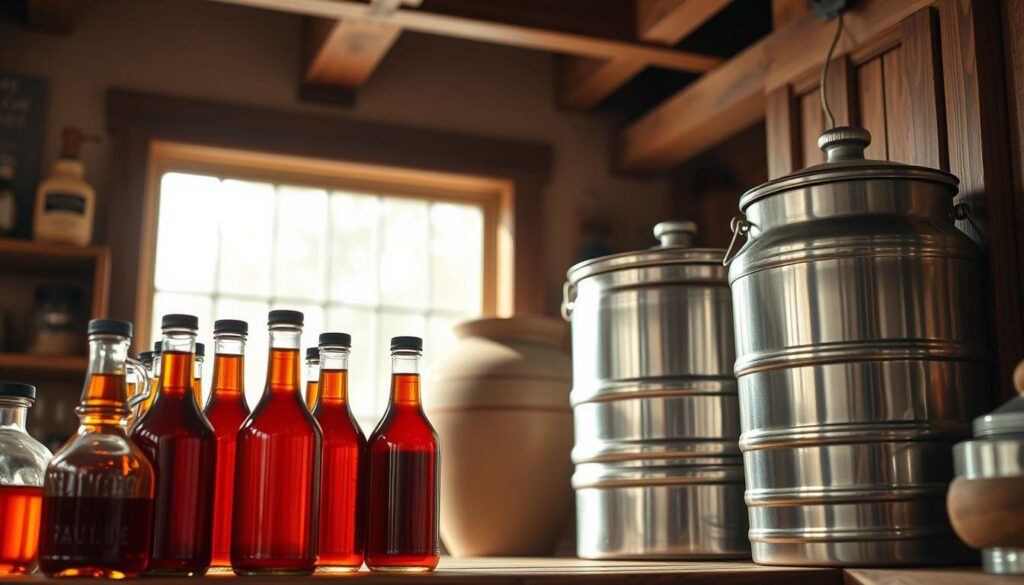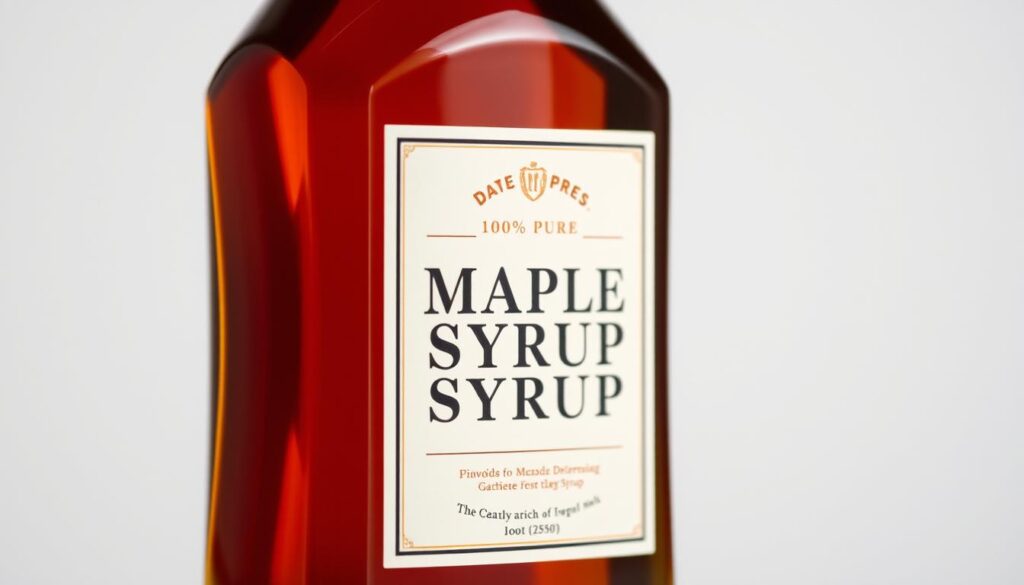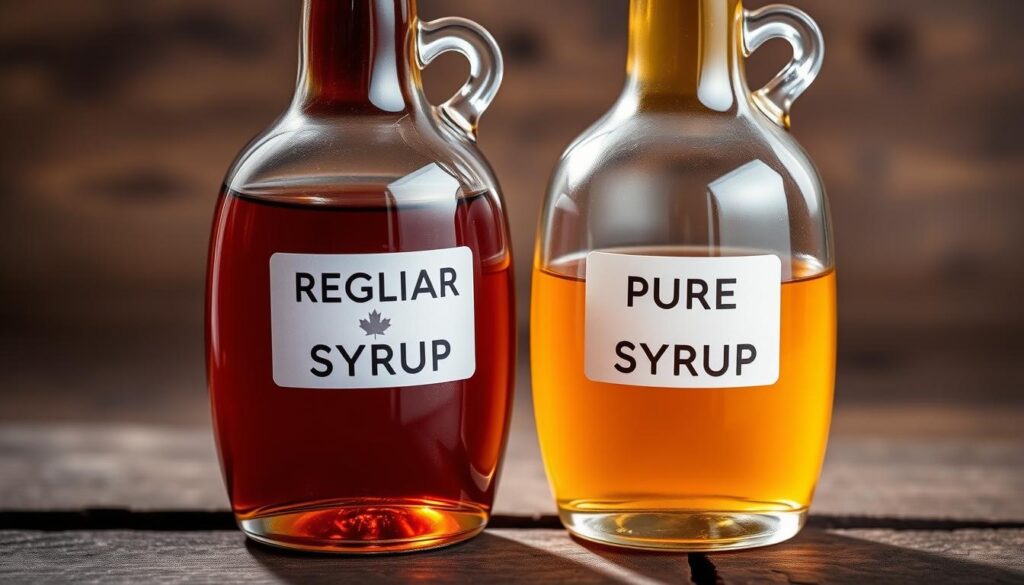Maple syrup is a favorite sweetener in the United States. It has two main types: regular and pure maple syrup. These two might look similar at first, but they are quite different.
Pure maple syrup is made from the sap of maple trees. It’s collected and boiled down by experts in places like Vermont and New Hampshire. The sap is tapped from trees at the right time, then boiled to make syrup.
Regular maple syrup, on the other hand, often has artificial ingredients and corn syrup. It’s a more processed version compared to pure maple syrup. While it tastes like real maple syrup, it doesn’t have the same nutritional value or taste.
The differences between regular and pure maple syrup go beyond how they’re made. They also differ in nutrition, taste, environmental impact, and quality. People who care about what they eat want to know the truth about their food. So, knowing the difference between these syrups is very important.
In this article, we’ll dive into the world of maple syrup. You’ll learn how each type is made, what makes them unique, and why pure maple syrup is a special treat. From the forest to your table, maple syrup’s journey is one of tradition and natural goodness.
What Is the Difference Between Regular and Pure Maple Syrup?
Maple syrup lovers and chefs know the big differences between pure and regular maple syrup. These differences are in how they’re made, what’s in them, and their quality. Each type is special in its own way.
To understand Maple Syrup Types, we need to look at their basic features. Pure maple syrup comes straight from maple tree sap. Regular maple syrup, on the other hand, often has artificial processing and extra ingredients.
Understanding Basic Characteristics
The main differences between pure and regular maple syrup are:
- Where the ingredients come from
- How they’re made
- What they taste like
- What’s in them for nutrition
Core Components and Ingredients
Pure maple syrup is made from just one thing: concentrated maple tree sap. Regular maple syrup, though, has:
- High fructose corn syrup
- Artificial maple flavoring
- Preservatives
- More sweeteners
| Characteristic | Pure Maple Syrup | Regular Maple Syrup |
|---|---|---|
| Primary Ingredient | 100% Maple Sap | Corn Syrup & Artificial Flavors |
| Processing | Natural Boiling | Industrial Manufacturing |
| Nutritional Value | High Mineral Content | Limited Nutritional Benefits |
Natural vs Artificial Production Methods
Making pure maple syrup is a traditional process. It involves tapping maple trees and boiling the sap carefully. Regular maple syrup, though, goes through a lot of industrial processing. This often loses its natural taste.
Pure maple syrup is a direct link to nature’s sweetness. It’s made with skill passed down through generations.
The History and Origins of Maple Syrup Production
The tale of maple syrup starts with North America’s indigenous peoples. They first found the sweet treasure in maple trees. Native American tribes, mainly in the northeastern areas, started the first maple syrup classification and extraction methods before European settlers came.
Indigenous communities created advanced ways to collect maple sap. They used simple tools and knowledge passed down through generations. They made cuts in maple trees and gathered sap in birch bark containers. Then, they boiled it to make sweet syrup.
“Maple syrup was more than a food—it was a cultural treasure that connected indigenous people to the land and its natural rhythms.”
After European colonization, the maple syrup classification system changed a lot. French settlers learned from Native Americans and improved the methods. By the 19th century, maple syrup production became commercial in places like Quebec and Vermont.
- Early 1700s: Indigenous maple sap collection techniques
- Mid-1800s: First commercial maple syrup operations
- Early 1900s: Standardized maple syrup classification emerges
As technology got better, sugarmakers found new ways to tap and process maple sap. They introduced metal tools, special boiling equipment, and later vacuum-assisted systems. These changes turned maple syrup production into a modern agricultural practice.
Today’s maple syrup classification shows the mix of cultural knowledge and new technology. It honors the legacy of those who first saw the sweet side of maple trees.
Pure Maple Syrup: From Tree to Table
The journey of pure maple syrup is amazing. It turns natural tree sap into a tasty treat. Sugarmakers make Grade A Maple Syrup with care, following a tradition that honors maple syrup’s heritage.
Maple Tree Selection
Choosing the right maple trees is key for top-notch Grade B Maple Syrup. Sugarmakers pick mature sugar maple trees that are at least 40 years old and 10 inches wide. These trees need to be healthy and have strong roots and dense leaves for good sap.
- Sugar maple trees (Acer saccharum) are preferred
- Trees must be mature and healthy
- Minimum diameter of 10 inches
- Optimal tree age: 40-100 years
Sap Collection Process
Collecting sap is an art that needs precision and patience. In late winter and early spring, maple trees start producing sap when it’s cold at night and warm during the day.
“The magic of maple syrup happens in those brief moments when nature allows sap to flow,” says a traditional sugarmaker.
- Drill small holes into maple tree bark
- Insert spiles to direct sap flow
- Collect sap in buckets or through tubing systems
- Transport sap to sugar house quickly
Boiling and Processing Methods
Turning raw sap into pure maple syrup needs skilled boiling. Sugarmakers heat the sap in big evaporators, removing water and focusing the sugars. This step decides the syrup’s grade, whether it’s Grade A or Grade B.
It takes 40 gallons of sap to make just one gallon of pure maple syrup. This process makes a sweetener that’s rich and full of the maple tree’s essence.
Regular Maple Syrup: Manufacturing Process
Understanding the difference between regular and pure maple syrup starts with their making processes. Regular maple syrup uses an industrial method to create a maple-flavored product. It tries to match the taste of real maple syrup.
The steps to make regular maple syrup include:
- Combining corn syrup as a primary base
- Adding artificial maple flavoring
- Incorporating chemical coloring agents
- Blending and standardizing the mixture
Manufacturers start with corn syrup as the base. This sweetener gives a consistent texture and is cheaper than pure maple sap. They add artificial maple flavoring to mimic the real syrup’s taste.
The making process uses industrial techniques:
- Large-scale ingredient mixing
- Chemical flavor enhancement
- Color standardization
- High-volume bottling
Looking at these methods, we see the difference between regular and pure maple syrup. Pure maple syrup comes from natural sap and has little processing. Regular maple syrup, on the other hand, uses synthetic ingredients and industrial methods for a maple-like taste.
The goal is to produce an affordable, consistent maple-flavored syrup that appeals to mass-market consumers.
Nutritional Comparison of Pure vs Regular Maple Syrup
Knowing the nutritional differences between regular and pure maple syrup helps us make better food choices. Both syrups are sweet, but they have different nutritional values.
Pure maple syrup is a better choice for nutrition compared to regular syrup. Its natural production keeps more nutrients than regular syrup’s manufacturing process.
Vitamin and Mineral Content
Pure maple syrup has nutrients that regular syrup doesn’t:
- Manganese: Supports bone health and metabolism
- Zinc: Boosts immune system function
- Calcium: Promotes strong bones and teeth
- Potassium: Regulates heart and muscle function
Sugar Content Analysis
| Syrup Type | Sugar Content per 100g | Calories |
|---|---|---|
| Pure Maple Syrup | 67g | 260 |
| Regular Maple Syrup | 76g | 290 |
Health Benefits Comparison
Pure maple syrup has more natural health benefits than regular syrup. It has antioxidants that may fight inflammation and boost health. Regular syrup, made with artificial ingredients, doesn’t have these benefits.
For a healthier sweetener, pure maple syrup is the better choice. It has a better nutritional profile and is less processed.
Understanding Maple Syrup Grades and Classifications
Maple syrup grades are key to knowing the quality and taste of this natural sweetener. The Maple Syrup Classification system helps people see the special qualities of each syrup type.
The United States Department of Agriculture (USDA) has four main maple syrup grades:
- Golden Color, Delicate Taste: Lightest grade with a mild maple flavor
- Amber Color, Rich Taste: Slightly darker with a more pronounced maple profile
- Dark Color, Robust Taste: Deep color with strong maple characteristics
- Very Dark Color, Strong Taste: Most intense maple flavor available
Each Maple Syrup Grade shows the syrup’s season and flavor. Syrups from early seasons are lighter, while those from later seasons are darker and more intense.
| Grade | Color | Flavor Intensity | Harvest Period |
|---|---|---|---|
| Golden | Very Light | Mild | Early Season |
| Amber | Light Amber | Medium | Mid Season |
| Dark | Dark Amber | Strong | Late Season |
| Very Dark | Deep Brown | Intense | End of Season |
Sugarmakers watch the Maple Syrup Classification closely to meet quality standards. This helps consumers pick syrups that fit their taste and cooking needs.
Taste Profile Differences Between Pure and Regular Syrup
The world of maple syrup is full of flavor complexity. When you compare pure maple syrup vs regular syrup, you’ll notice big differences. These differences are clear to anyone who loves good taste.
Pure maple syrup is a true culinary treasure. It has a rich taste that comes from nature. Unlike regular syrup, which might have artificial flavors, pure maple syrup offers a real taste experience.
Flavor Notes and Complexity
The taste journey of pure maple syrup is amazing. Sugarmakers make these syrups with special flavors. These flavors change with the season and the type of maple tree:
- Golden syrup: Delicate, mild flavor with subtle sweetness
- Amber syrup: Rich, more pronounced maple notes
- Dark syrup: Intense, robust flavor with deep caramel undertones
Sweetness Levels
When you look at pure maple syrup vs regular syrup, sweetness is key. Pure maple syrup has a balanced sweetness. It doesn’t overpower your taste buds.
“Pure maple syrup is nature’s liquid gold, with a complexity that artificial syrups can never replicate.” – Artisan Sugarmaker
Regular maple-flavored syrups often use corn syrup. This makes them sweet but lacks the depth of pure maple syrup. Pure maple syrup’s natural sugars give a more refined taste.
Cost Factors and Market Pricing
The world of maple syrup pricing is complex and fascinating. Pure maple syrup is expensive because it’s made with hard work and natural ingredients. Different types of maple syrup cost a lot, showing the unique challenges of making them.
How much it costs to make maple syrup is key. Making pure maple syrup needs a lot of manual work and special weather. Sugarmakers spend hours collecting sap, boiling it, and making the syrup.
“Producing pure maple syrup is an art form that demands patience and precision.” – Vermont Maple Sugar Makers Association
Several things affect maple syrup prices:
- Seasonal harvesting limitations
- Sap collection complexity
- Processing equipment investments
- Geographic production constraints
There’s a big price gap between different maple syrups. Pure maple syrup is 3-5 times pricier than regular maple-flavored syrups.
| Maple Syrup Type | Average Price per Gallon | Production Complexity |
|---|---|---|
| Pure Maple Syrup | $60 – $80 | High |
| Regular Maple-Flavored Syrup | $10 – $15 | Low |
Market trends show increasing consumer preference for authentic, pure maple syrup despite higher prices. Buyers value the high quality and traditional making of pure maple syrup. This makes it a premium product.
Shelf Life and Storage Requirements
Storing maple syrup right is key to keeping its quality and taste. The way you store it affects how long it lasts and how it tastes.

Knowing how to store maple syrup well helps fans keep their favorite sweetener fresh. This way, they can enjoy it at its best.
Proper Storage Methods
Keeping maple syrup top-notch involves smart storage:
- Unopened Grade A Maple Syrup should be kept in a cool, dark place.
- After opening, put it in the fridge to stop it from going bad.
- Use sealed containers to keep out moisture and harmful stuff.
- For storing, glass or food-grade plastic containers are best.
Signs of Spoilage
Spotting when maple syrup goes bad is important. Look out for:
- Mold on the surface
- Strange smells
- It starts to crystallize or ferment
- Big color changes
“Maple syrup’s natural purity demands attentive storage practices” – Artisan Sugarmakers Association
Grade B Maple Syrup usually lasts a bit less time in the fridge than Grade A. It stays good for 12-18 months when stored right. Freezing can keep it fresh for years without losing its taste or nutrients.
Culinary Applications and Uses
Knowing the difference between regular and pure maple syrup changes how we cook. Pure maple syrup adds a rich, complex taste that makes dishes more than just breakfast items.
Chefs and home cooks love pure maple syrup for its many uses. Its unique flavor is perfect for different recipes:
- Baking: Replaces sugar in cakes, cookies, and pastries
- Savory Dishes: Glazes meats and roasted vegetables
- Marinades: Adds depth to grilling recipes
- Breakfast Preparations: Makes pancakes, waffles, and french toast better
The difference between regular and pure maple syrup is clear in cooking. Pure maple syrup adds real, natural sweetness with hints of the forest.
| Culinary Category | Pure Maple Syrup | Regular Maple Syrup |
|---|---|---|
| Baking | Excellent flavor complexity | Limited flavor profile |
| Marinades | Rich, natural sweetness | Basic sweetening |
| Breakfast | Gourmet topping | Standard sweet topping |
“Pure maple syrup isn’t just a condiment—it’s a culinary ingredient with remarkable depth and character.” – Professional Chef
Regular maple syrup is mainly used for sweetness. But pure maple syrup changes recipes with its real, complex taste. The choice depends on what you want to achieve in your cooking.
Environmental Impact of Production Methods
Understanding the environmental impact of Regular vs Pure Maple Syrup is key for eco-conscious consumers. Maple syrup production is a balance between human actions and nature. It shows how we can live in harmony with the environment.
Producing maple syrup sustainably means managing forests well and keeping nature intact. Traditional methods of making maple syrup are much better for the planet than industrial ways.
Sustainability in Maple Forest Ecosystems
Pure maple syrup helps keep forests healthy by tapping trees responsibly. Sugarmakers pick trees carefully to avoid harm and keep forests strong for years.
- Maple trees can be tapped for 100-150 years
- Sustainable harvesting preserves forest biodiversity
- Traditional methods minimize environmental disruption
Carbon Footprint Comparison
| Production Method | Carbon Emissions | Environmental Impact |
|---|---|---|
| Pure Maple Syrup | Low | Minimal forest disruption |
| Regular Maple Syrup | High | Significant industrial processing |
Regular maple syrup often uses corn syrup and artificial stuff, leading to more carbon emissions. Choosing pure maple syrup is a greener option for those looking for eco-friendly sweeteners.
Climate change is a big worry for maple syrup makers. Changes in weather could hurt sugar maple forests. So, it’s more important than ever to use sustainable practices to save this important tradition.
Reading Labels: What to Look For

Choosing between Pure Maple Syrup and Regular can be tough. Knowing what labels say helps you pick the right one. It also ensures you get real maple syrup.
When you look at maple syrup labels, pay close attention to important details. These details help you tell pure maple syrup from other kinds.
- Look for “100% Pure Maple Syrup” clearly shown
- Check if the ingredient list only has maple syrup
- Make sure it’s made in a country known for maple syrup
- Look at the grade it’s classified as
Pure maple syrup labels usually show how it’s made clearly. But regular maple syrup might have things like corn syrup or fake flavors added.
| Label Indicator | Pure Maple Syrup | Regular Maple Syrup |
|---|---|---|
| Primary Ingredient | 100% Maple Sap | Corn Syrup, Artificial Flavors |
| Production Region | Specific Maple Forests | Generic Manufacturing |
| Price Range | Higher Cost | Lower Cost |
“True maple syrup tells a story of craftsmanship and natural heritage” – Maple Producers Association
Knowing what labels mean helps avoid tricks in marketing. Always check the packaging to make sure you’re getting real Pure Maple Syrup, not a fake.
Common Misconceptions About Maple Syrup
Maple syrup is filled with myths that confuse people about its true nature and quality. Knowing these myths helps buyers make better choices when picking maple syrup.
Many myths about Maple Syrup Types exist in the cooking world:
- All maple syrups taste exactly the same
- Pure and regular maple syrups are nutritionally equivalent
- Maple syrup production is a simple, uniform process
- Darker syrups are lower quality
The truth about maple syrup is more complex. Pure maple syrup is a complex agricultural product with many variations in flavor, production, and nutrition. Sugarmakers carefully make each batch, knowing that small differences come from tree choice, collection methods, and processing.
Color and grade are key in maple syrup’s characteristics. Darker syrups often have stronger flavors and more minerals. Light amber syrups are sweeter, while darker ones are richer and more intense.
Pure maple syrup has more nutrients than regular syrup. It has minerals like manganese and zinc, while processed syrups might not. Those looking for real nutritional value should choose pure Maple Syrup Types from trusted sources.
True maple syrup represents a unique culinary tradition, not just a simple sweetener.
Knowing these differences helps consumers make smart choices about maple syrup. It shows the skill behind this beloved natural product.
Seasonal Availability and Production Cycles
Maple syrup production has a special seasonal rhythm. It’s different from many other foods. The process starts with nature’s timing, usually from late February to early April.
The maple syrup harvest needs the right weather. Sugarmakers look for nights that freeze and days that warm up. This creates the perfect sap flow. Places like Vermont, New Hampshire, and New York are best for this.
- Optimal sap collection occurs when temperatures fluctuate between 20°F and 40°F
- The typical harvesting season lasts 4-6 weeks
- Each maple tree produces approximately 10-20 gallons of sap per season
Pure maple syrup is only available for a short time. Grade A Maple Syrup gets lighter as the season starts. Later, Grade B Maple Syrup becomes darker and stronger.
“Maple syrup is nature’s calendar, marking the transition from winter to spring with its sweet harvest.” – Traditional Sugarmaker Wisdom
Producers have to manage their syrup carefully. The production window is very short. This makes maple syrup special and valuable, showing nature’s perfect timing.
Conclusion
Maple syrup is more than just sweet. The difference between regular and pure maple syrup is clear. Pure maple syrup comes from maple tree sap, showing a traditional and green way to make sweeteners.
Now, people know the special traits of each syrup type. Pure maple syrup’s collection process is detailed, unlike regular syrup’s mass production. This shows why choosing what we eat matters.
The taste, health benefits, and how it’s made are key differences. These points help us decide what maple syrup to pick. It’s about taste, health, or caring for the planet.
Maple syrup’s history is rich and growing. It’s for those who love food and care about health. Pure maple syrup offers a real taste of nature’s sweetness.



